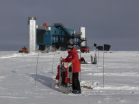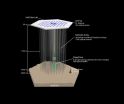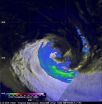INFORMATION:
Article: http://journals.aps.org/prd/abstract/10.1103/PhysRevD.91.072004
Contact:
Jason Koskinen, Assistant Professor and head of the IceCube Group at the Niels Bohr Institute, University of Copenhagen, +45 2128-9061, koskinen@nbi.ku.dk
Morten Medici, PhD student, IceCube Group at the Niels Bohr Institute, University of Copenhagen, +45 3532-5454, +45 6151-6464, mmedici@nbi.ku.dk
Detector at the South Pole explores the mysterious neutrinos
2015-04-16
(Press-News.org) Neutrinos are a type of particle that pass through just about everything in their path from even the most distant regions of the universe. The Earth is constantly bombarded by billions of neutrinos, which zip right through the entire globe, houses, animals, people - everything. Only very rarely do they react with matter, but the giant IceCube experiment at the South Pole can detect when there is a collision between neutrinos and atoms in the ice using a network of detectors. New research results from the Niels Bohr Institute among others have measured the neutrinos at the South Pole and have calculated some of the physical properties of the otherwise exotic and poorly understood particles. The results are published in the scientific journal Physical Review D.
Neutrinos are among nature's most abundant particles. Their number far exceeds the number of atoms in the entire universe - yet we know little about them. Neutrinos are a type of particle created in the Big Bang and are also produced in the Sun's interior and in violent events like supernovae, which are exploding stars. Neutrinos are also called 'ghost particles' because they basically do not interact with matter, but pass undisturbed through everything in their path.
Instruments at the South Pole
Researchers from 44 institutions in 12 countries are part of an international project, IceCube at the South Pole to study the mysterious particles with the strange properties.
IceCube is an enormous particle detector located deep in the ice at the South Pole. The instruments in the detector are comprised of 86 cables each with 60 digital Optical Modules (extremely sensitive light sensors). Each cable is lowered down into a hole, which is melted through the 2½ km ice sheer using a hot water drill. The detector is located deep below the surface - it starts 1½ km below the ice and ends at the bottom at a depth of 2½ km.
The detector's enormous size of a cubic kilometer is necessary because neutrinos interact extremely weakly with matter, so it is only rarely that they collide with the atoms in the ice. When they finally collide, charged particles are created, which emit radiation that can be detected by the extremely sensitive Digital Optical Modules.
"In the Ice Cube project we have registered about 35 neutrinos, which are very likely to have come distant regions in space. They have a very high energy and because they have not interacted during their long journey, they can carry information from the most distant parts of the universe. In addition to the rare cosmic neutrinos, we are also studying the neutrinos created in the Earth's atmosphere in order to unravel the physical properties of neutrinos," says Jason Koskinen, Assistant Professor and head of the IceCube Group at the Niels Bohr Institute, University of Copenhagen.
From the North Pole to the South Pole
When particles (protons) with high energy - from violent events in the cosmos like supernovae and quasars hit the Earth's atmosphere, a burst of neutrinos is formed, which passes through the Earth. The neutrinos formed over the North Pole pass straight through the Earth and very small proportion of them hit the ice at the South Pole, where the IceCube detector registers the collisions.
Neutrinos are very light particles and for many years it was believed that they were completely massless. It is now believed that there are three types of neutrinos (electron, muon and tau neutrinos), each with their specific mass, which is incredibly small - less than a millionth of the mass of an electron.
"The neutrinos created in the atmosphere over the North Pole are mostly muon neutrinos. On their way through the Earth's 13,000 km, the muon neutrinos undergo quantum fluctuations that can change them into another type of neutrino, tau neutrinos, before they are finally detected by IceCube on the other side of the globe. We can now study these effects in much greater detail than before and in this way we can gain new insights into their physical characteristics," explains Jason Koskinen.
Atmospheric neutrinos
The research group has now studied atmospheric neutrinos in the IceCube detector at the South Pole for three years and have analysed 5,200 interactions between atmospheric neutrinos and atoms in the ice.
"We have confirmed that neutrinos undergo fluctuations - even at high energy levels and we have calculated how much they exhibit these oscillations. In this study, we have only measured muon neutrinos and in comparison to how many muon neutrinos form in in the atmosphere and pass through the Earth, we only see a fraction at the South Pole. The explanation is that the muon neutrinos undergo quantum fluctuations that change them into tau neutrinos and we do not see those. If they had not changed, we would see them all. Our calculations show that 20 percent have undergone quantum fluctuations and changed from muon neutrinos to another type of neutrino as they pass through the Earth," explains Jason Koskinen.
Messengers from the universe
And then what, you might ask? "Because we basically want to learn more about these strange particles that are everywhere in the universe and whose properties we still do not fully understand. Because neutrinos come from the cosmos, we could use them for astronomical observations and gain new insights into the structure of the universe," says Jason Koskinen.
ELSE PRESS RELEASES FROM THIS DATE:
GPM sees wind shear affecting remnants of Extra-tropical Cyclone Joalane
2015-04-16
The GPM satellite showed the effects of wind shear and waning rainfall rates in Extra-tropical Cyclone Joalane as it was moving in a southeasterly direction through the Southern Indian Ocean.
The Global Precipitation Measurement (GPM) core observatory satellite had a last look at the remnants of Tropical Cyclone Joalane on April 14, 2015 at 1135 UTC (4:35 p.m. local time/7:35 a.m. EDT/U.S.).
GPM's Microwave Imager (GMI) instrument found very little rainfall around Joalane's center and light to moderate rainfall in bands on the outer edges of the rapidly weakening tropical ...
Research identifies barriers in tracking meals and what foodies want
2015-04-16
Eating healthy is sometimes a challenge on its own, so technology should ease that burden - not increase it - according to new research from the Georgia Institute of Technology and University of Washington. Researchers studied how mobile-based food journals integrate into everyday life and specific challenges when using food journaling technology. Their research suggests how future designs might make it easier and more effective.
The research study uncovered three problem areas: barriers to reliable food entry, negative nudges in current food journal apps and challenges ...
New transitional stem cells discovered
2015-04-16
COLUMBIA, Mo. - Pre-eclampsia is a disease that affects 5 to 8 percent of pregnancies in America. Complications from this disease can lead to emergency cesarean sections early in pregnancies to save the lives of the infants and mothers. Scientists believe pre-eclampsia is caused by a number of factors, including shallow placentas that are insufficiently associated with maternal blood vessels. Now, researchers from the University of Missouri, in an effort to grow placenta cells to better study the causes of pre-eclampsia, serendipitously discovered a previously unknown form ...
Botox makes unnerving journey into our nervous system
2015-04-16
New research might bring a frown to even the most heavily botoxed faces, with scientists finding how some of the potent toxin used for cosmetic surgery escapes into the central nervous system.
Researchers at The University of Queensland have shown how Botox - also known as Botulinum neurotoxin serotype A - is transported via our nerves back to the central nervous system.
Botox - best known for its ability to smooth wrinkles - has been extremely useful for the treatment of over-active muscles and spasticity as it promotes local and long-term paralysis.
UQ Queensland ...
Faculty in doctoral programs more responsive to white male prospective students, research finds
2015-04-16
WASHINGTON - Faced with requests to meet with potential doctoral students of easily identifiable gender, race or ethnicity, faculty in almost every academic discipline are significantly more responsive to white males than to women and minorities, according to research published by the American Psychological Association.
And faculty in higher-paid disciplines, such as business, engineering/computer science and the life sciences, and those at private universities, show more of this bias than their counterparts in lower-paying disciplines and public universities, the study ...
EARTH: Fire-driven clouds and swirling winds whipped up record-setting New Mexico blaze
2015-04-16
Alexandria, VA--The massive 2011 Las Conchas Fire near Los Alamos, N.M., defied conventional fire science wisdom by racing downhill instead of uphill, and increasing intensity overnight. Now, EARTH Magazine brings you recent scientific analysis of the fire from a research team at Los Alamos National Lab.
A team led by atmospheric scientist Young-Joon Kim determined that two unique atmospheric effects -- mountain waves and pyro-cumulus clouds -- interacted in an explosive way to fan the flames over New Mexico. Read more about the new research and how it compares to traditional ...
Novel neurodegenerative disease and gene identified with the help of man's best friend
2015-04-16
A breakthrough study performed in an international collaboration led by Professor Tosso Leeb from the University of Bern and Professor Hannes Lohi from the University of Helsinki together with the veterinary neurologists and neuropathologists at the Faculty of Veterinary Medicine in the University of Helsinki has identified a gene mutation that causes a novel type of neurodegenerative disease in dogs. The results of the study shed light into the function of neurons, provide a new gene for human neurodegenration, and may aid in developing better treatments for neurodegenerative ...
Novel online bioinformatics tool significantly reduces time of multiple genome analysis
2015-04-16
UK research collaboration develops a new bioinformatics pipeline that enables automated primer design for multiple genome species, significantly reducing turnaround time.
With a rising global population leading to increased pressure on food resources, it is becoming ever more essential that crop breeding programmes work to enhance the security of global food sources.
A key aspect of this is utilising breakthroughs in genomics research to guide the selection of the individuals to incorporate in breeding schemes. It is possible to relate the DNA of a species to its physical ...
Rainforest protection akin to speed limit control
2015-04-16
The destruction of the Brazilian rainforest has slowed significantly. With around 5000 square kilometers annually, the loss is now about 80% lower than in 2004. Led by the Center for Development Research (ZEF) at the University of Bonn, an international team of researchers has evaluated the effectiveness of forest law enforcement in the Brazilian Amazon. In some federal states of the Brazilian Amazon region enforcement has been more effective than in others. The results are presented in the journal "PLOS ONE".
Deforestation of the Amazon rainforest featured in international ...
Novel plasma diagnostics method
2015-04-16
Could the mundane action of switching on an energy saving light bulb still hold secrets? It does, at least for physicists. These bulbs are interesting because they contain low-temperature plasma - a gas containing charges from ions and electrons. Now, a German team has developed a method that could be used for measuring the increase in the plasma force on the inner side of such a light bulb when the light is switched on. These findings from Thomas Trottenberg and colleagues from Christian-Albrechts University in Kiel, Germany, have just been published in EPJ D. They have ...





